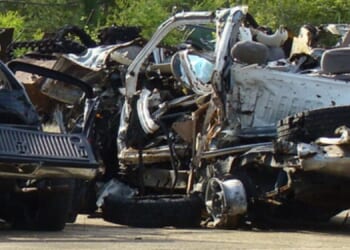The retirement of Spain’s Harrier jets without an alternative puts Madrid in an unusual situation: by the mid-2030s, it may have an aircraft carrier without any fixed-wing aircraft to operate.
In August, Spain announced it would not move forward with a deal to acquire the Lockheed Martin F-35 Lightning II, opting instead to either purchase additional Eurofighter Typhoon fighters or wait for the arrival of the Future Combat Air System (FCAS), the sixth-generation fighter now under development and scheduled to enter service in the mid-2030s.
As previously reported, Madrid has operated the Eurofighter since 2003, which began to replace its fleet of aging McDonnell Douglas F/A-18 Hornets. The Typhoons are operated from Morón (11th Wing) and Los Llanos (14th Wing) air bases. Last December, Spain placed an order for 25 upgraded Eurofighter Tranche 4 models under its Halcon II program. Deliveries of those aircraft are slated to be completed between 2030 and 2035.
Prior to its decision to suspend plans to buy the F-35, Spain first expressed interest in the American fifth-generation fighter in 2017. Until mid-2025, it had sought to acquire both the F-35A, the conventional takeoff and landing (CTOL) model, and the F-35B, the short takeoff and vertical landing (STOVL) variant.
In the absence of F-35s, additional Eurofighters have been considered a suitable replacement for the older Hornets. However, the Typhoon can’t operate from the Spanish Navy’s flagship, the Juan Carlos I multipurpose aircraft carrier/landing helicopter dock, while F-35Bs could. The warship is equipped with a ski jump for STOVL operations; at present, its air wing consists of the McDonnell Douglas AV-8B Harrier II, which is scheduled to be retired by the early 2030s.
An Aircraft Carrier Without Aircraft?
The retirement of the Harrier jets without an alternative puts Madrid in an unusual situation: by the mid-2030s, its aircraft carrier may not have any fixed-wing aircraft to operate. (The carrier will continue to operate rotary-wing aircraft, including attack helicopters.)
There are now reports that the Spanish Navy is also exploring options that could extend the Harriers’ operational life.
Zona Militar reported that Admiral General Antonio Piñeiro, Chief of Staff of the Navy (AJEMA), has indicated that options are being considered, stating, “We will maintain the Harriers with a schedule that contemplates reaching 2032.” Speaking at the Forum for New Defense and Space, Piñeiro further indicated that among the options is to acquire decommissioned Harriers from the United States Marine Corps or the Italian military.
Those aircraft wouldn’t be reactivated, but instead would be used as a “source of spare parts,” Zona Militar explained.
Spain Wants a New Carrier—but Probably Can’t Afford It
Another option being considered would be for the Spanish Navy to build a new aircraft carrier capable of hosting up to 30 aircraft. Piñeiro suggested it would be similar in size to the French Navy’s Charles de Gaulle flagship, but conventionally powered instead of employing nuclear propulsion.
A larger Spanish aircraft carrier could operate with the F-35C, the carrier-based version of the Joint Strike Fighter, or the French-made Dassault Rafale-M, which is in service with the Charles de Gaulle and has also been adopted by the Indian Navy for its carriers.
However, given that Madrid had backed out of the F-35 deal due to political and financial reasons, it seems unlikely that Spain could both afford to build a new carrier and then purchase new fifth-generation aircraft to operate from it.
Protected by its distance from Eastern Europe—the front line of the Cold War, and almost certain to be the flashpoint of any future NATO conflict—Spain’s defense budget is one of the smallest in Europe’s. At the 2025 NATO summit in The Hague, Netherlands, Spain notoriously became the only alliance member to refuse to commit to spending 5 percent of its gross domestic product (GDP) on defense. Madrid requested, and received, an exemption to the rule, allowing it to spend only 2 percent.
The only viable option is for the Juan Carlos I to continue to operate the Harrier II as long as it can, and then, beginning in the 2030s, transition to rotary aircraft and drones. This is something that might not be the worst course of action—especially for a nation that wants to keep a smaller military defense budget.
About the Author: Peter Suciu
Peter Suciu has contributed over 3,200 published pieces to more than four dozen magazines and websites over a 30-year career in journalism. He regularly writes about military hardware, firearms history, cybersecurity, politics, and international affairs. Peter is also a contributing writer for Forbes and Clearance Jobs. He is based in Michigan. You can follow him on Twitter: @PeterSuciu. You can email the author: [email protected].
Image: Shutterstock / GEORGE STAMATIS.


















